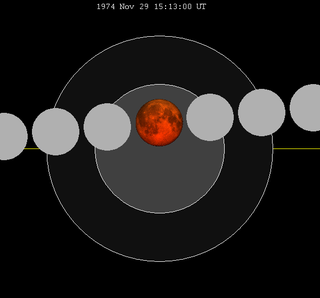
A partial lunar eclipse took place on Thursday, July 26, 1934.

A partial lunar eclipse took place on Thursday, July 26, 1934.
| Descending node | Ascending node | |||||
|---|---|---|---|---|---|---|
| Saros | Date Viewing | Type Chart | Saros | Date Viewing | Type Chart | |
| 103 | 1933 Feb 10  | Penumbral | 108 | 1933 Aug 05  | Penumbral | |
| 113 | 1934 Jan 30  | Partial | 118 | 1934 Jul 26  | Partial | |
| 123 | 1935 Jan 19  | Total | 128 | 1935 Jul 16  | Total | |
| 133 | 1936 Jan 08  | Total | 138 | 1936 Jul 04  | Partial | |
| 143 | 1936 Dec 28  | Penumbral | ||||
A lunar eclipse will be preceded and followed by solar eclipses by 9 years and 5.5 days (a half saros). [1] This lunar eclipse is related to two annular solar eclipses of Solar Saros 125.
| July 20, 1925 | August 1, 1943 |
|---|---|
 |  |

A total lunar eclipse took place on Friday, February 9, 1990, the first of two lunar eclipses in 1990.

A penumbral lunar eclipse took place on November 20, 2002, the last of three lunar eclipses in 2002.

A penumbral lunar eclipse took place on Monday, June 24, 2002, the second of three lunar eclipses in 2002. This penumbral eclipse was visibly imperceptible due to the small entry into the southern penumbral shadow.

A penumbral lunar eclipse took place on Sunday, January 31, 1999, the first of two lunar eclipses in 1999.

A penumbral lunar eclipse took place on Sunday, September 6, 1998, the last of three lunar eclipses in 1998.

A total lunar eclipse will take place on May 26, 2040. The northern limb of the moon will pass through the center of the Earth's shadow. This is the second central lunar eclipse of Saros series 131.
A total lunar eclipse took place on Monday, October 28, 1985, the second of two total lunar eclipses in 1985, the first being on May 4, 1985.

A partial lunar eclipse took place on Monday, August 6, 1990, the second of two lunar eclipses in 1990.

A penumbral lunar eclipse took place on Thursday, June 27, 1991, the second of four lunar eclipses in 1991. The moon entered the Earth's penumbra for about 3 hours, and was difficult to see. This lunar eclipse is the predecessor of the Solar eclipse of July 11, 1991.

A penumbral lunar eclipse took place on Friday, July 26, 1991, the third of four lunar eclipses in 1991. This was the 2nd member of Lunar Saros 148. The previous event was on 15 July 1973, and the 1st eclipse of the series. The next event was on 6 August 2009.

A penumbral lunar eclipse took place on Wednesday, January 30, 1991, the first of four lunar eclipses in 1991.

A total lunar eclipse took place on Friday, November 29, 1974, the second of two lunar eclipses in 1974.

A partial lunar eclipse will take place on Wednesday, January 12, 2028.

A partial lunar eclipse will take place on Thursday, July 6, 2028.
A total lunar eclipse took place on Thursday, September 6, 1979, the second of two lunar eclipses in 1979. A shallow total eclipse saw the Moon in relative darkness for 44 minutes and 24.7 seconds. The Moon was 9.358% of its diameter into the Earth's umbral shadow, and should have been significantly darkened. The partial eclipse lasted for 3 hours, 11 minutes and 54.1 seconds in total.
A penumbral lunar eclipse took place at the Moon's descending node of the orbit on Tuesday, August 26, 1980, the last of three penumbral lunar eclipses in 1980 with a penumbral magnitude of 0.70891. This subtle penumbral eclipse may have been visible to a skilled observer at maximum eclipse. 70.891% of the Moon's disc was partially shaded by the Earth, which caused a gentle shadow gradient across its disc at maximum; the eclipse as a whole lasted 3 hours, 34 minutes and 26 seconds.

A partial lunar eclipse will take place on November 30, 2039. At 3 hours 26 minutes, it is the longest partial lunar eclipse since November 19, 2021, which is the previous member of Lunar Saros 126.

A total lunar eclipse took place on Sunday, July 26, 1953.

A partial lunar eclipse will take place on June 26, 2048. The Moon will be strikingly shadowed in this deep partial eclipse lasting 2 hours and 39 minutes, with 63.88% of the Moon in darkness at maximum.

A total lunar eclipse will take place on April 26, 2051.